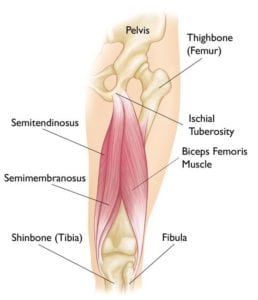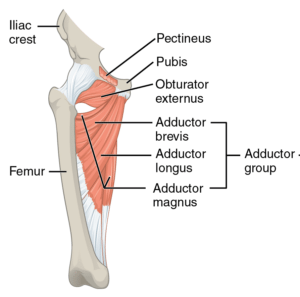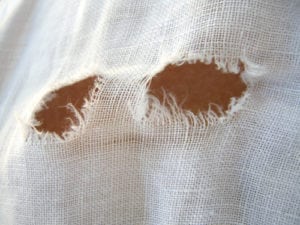Hamstring Strains: For the Love…Don’t Stretch!
Hamstring strains are one of the most annoying injuries to heal and rehab. If you’ve ever had one or are currently dealing with one, I know your nodding your head “yes.” It hurts to sit, walk, run, bend over, climb stairs and squat. It’s an injury that feels like it will never go away. But, it will if you load it right. Most information lurking around the world wide web states you should stretch a hamstring strain. Um, absolutely not. Ok, so if you shouldn’t stretch, then what should you do? There are two main concepts that must blend together to truly heal a hamstring strain.
What is a Hamstring Strain?
A hamstring strain (or any strain for the matter) is microscopic tearing of the muscle, fascia and/or tendon followed by an acute inflammatory response. The research suggests that during this process, the nociceptors (pain receptors) and mechanoreceptors (stretch receptors) become highly sensitive after a hamstring strain. This is why that tendon insertion hurts so much.
And, once you have a hamstring strain you are more susceptible to another one. So you need to heal these strains in a really healthy way…starting today!
Hamstring Anatomy
 The hamstring group is formed by three main long muscles: Semimembranosus, Semitendinosus and Biceps Femoris (long and short head). The main action of the hamstring group is to flex (bend) the knee. The hamstrings assist with hip control because of the insertion at the pelvis.
The hamstring group is formed by three main long muscles: Semimembranosus, Semitendinosus and Biceps Femoris (long and short head). The main action of the hamstring group is to flex (bend) the knee. The hamstrings assist with hip control because of the insertion at the pelvis.
Deep to the hamstring group, is a muscle called the Adductor Magnus (see below). It is a fanned-shape muscle that assists with many movements. The main action of the Adductor Magnus is to adduct (pull the leg to midline when it is out). This muscle also assists with knee flexion, hip control and rotation. The fanned-shaped muscle fibers make this muscle very susceptible to strains. Adductor Magnus strains are often misdiagnosed as hamstring strains.

Note: These are two different types of strains and require different loading in rehab for true healing.
What Causes a Hamstring Strain?
Here are the TOP 6 Reasons people with hamstring strains visit the clinic:
- Poor Neuromuscular Patterning – The hamstring is dominant with hip extension and activates before the Gluteus Maximus (GMax). This is highly dysfunctional. The GMax is the main driver of hip extension and it should activate before the hamstring.
- Weak Trunk/Pelvis/Hip Complex – This is usually the cause of item #1. Understanding the importance of a stable core with good hip mobility is necessary for healthy leg movement. Without this key concept, the body is in a continual state of compensation. And compensation leads to strains, injuries and pain.
- Decreased Eccentric Hamstring Strength – An eccentric contraction is one where the muscle is lengthening while contracting. Weight lifters will know these as “negatives.” Mastering healthy eccentric contractions is highly important for athletes. It allows for quick movements, long strides, deceleration and safe sport activity in all directions.
- Lack of Dynamic Warm-Up Before Activity or Sport – Good grief. Telling an athlete to warm-up before activity is like telling them to go to jail. It’s 3-5 minutes! A dynamic warm-up is essential for “priming the body” for sport and gives you a ton of feedback about what feels tight, uneven or stiff.
- Poor Hamstring Length – Wow, this is a hot mess out there. You need to have 80-85 degrees of hamstring length for healthy sport activity. Short muscles are weak muscles. Please refer to item #3.
- Excessive Stretch to the Hamstrings – Yoga, splits, gymnastics, dancing. These are all common causes of over-lengthening the hamstring. This is usually caused by item #2.
Why Should You Not Stretch a Hamstring Strain?
 As stated above, strains are micro-tearing or small “rips” in the muscle, fascia and/or tendon. When you stretch a strain, you are causing more tearing to an already disrupted muscle region. Stretching a strain will worsen the strain.
As stated above, strains are micro-tearing or small “rips” in the muscle, fascia and/or tendon. When you stretch a strain, you are causing more tearing to an already disrupted muscle region. Stretching a strain will worsen the strain.
Consider this example. Imagine a small worn spot on a T-shirt. It’s not torn or a complete hole, but the fabric is thin, weak and somewhat transparent. If you want to keep this T-shirt intact, would you stretch this area? Of course not. It would create a rip in the shirt. This is very similar to how a strain behaves.
If you stretch a strain, the most vulnerable tissue in that stretch is the strained part of the muscle. Knowing that a hamstring strain is already microtearing along that muscle/tendon, why would you stretch it to cause more tearing?
How Do You Heal a Hamstring Strain?
By the time most people address a hamstring strain, it has likely developed into a Hamstring Tendonosis.
Tendonosis = Tissue Degeneration = Tendon Infiltrated with Water & Stringy Collagen = Tendon is Weak
The only way to truly heal this tendon is with an Eccentric Hamstring Contraction. Research shows that the tendon will regenerate back to a strong tendon with 3-6 months of consistent, over-loaded eccentric hamstring contractions.
This point is very important to heal the tendon, but now you have to dig deeper. What is the CAUSE of the injury? Without this knowledge, hamstring injuries will continue to be pests forever.
There are two MAIN CONCEPTS that must blend together to truly heal a hamstring strain.
- Hamstring Eccentrics – These contractions help regenerate the weak, gooey tendon back to a strong, sturdy one.
- Healthy Core/Glute Activation BEFORE Hamstring Activation -Most people have an over-active hamstring that likes to do all the activity of the glute and core. Again, this is dysfunctional. You want the hamstring to be strong, but you also don’t want it trying to take on the entire load of the lower body.
In order for our body to function well, the Core/Glute complex MUST activate and stabilize before any leg movement. Without this trunk stability the body will compensate somewhere for that lack of stability. And, for most, this is why hamstring strains happen.
Below is a quick video demonstrating these two main concepts
-
- Glute/Core Activation before Hamstring Activation
- Hamstring Eccentrics
© 2018 and Beyond. ALL BLOG CONTENT at duncansportspt.com by Lori Duncan PT
BLOG TALK PODCAST:
Blog Talk – Hamstring Strains
ABOUT THE AUTHOR
 Lori Duncan, DPT, MTC, CPT is a respected Physical Therapist, Manual Therapist and Pilates instructor in Lafayette, CO. Lori is passionate about preventive physical therapy and education and is a nationally recognized presenter. She can be reached at [email protected]. You can also follow Duncan Sports Therapy and Wellness on Facebook & Instagram for more free tips and information.
Lori Duncan, DPT, MTC, CPT is a respected Physical Therapist, Manual Therapist and Pilates instructor in Lafayette, CO. Lori is passionate about preventive physical therapy and education and is a nationally recognized presenter. She can be reached at [email protected]. You can also follow Duncan Sports Therapy and Wellness on Facebook & Instagram for more free tips and information.
References
Alfredson H, Pietila T, Jonsson P, Lorentzon R. Heavy-load eccentric calf muscle training for the treatment of chronic achilles tendinosis. Am J Sports Med. 1998;26: 360-366
Benazzo F, Marullo M, Zanon G, Indino C, Pelillo F. Surgical management of chronic proximal hamstring tendinopathy in athletes: a 2 to 11 years of follow-up. J Orthopaed Traumatol. 2013;14:83-89.
Shield AJ, Bourne MN. Hamstring injury prevention practices in elite sport: evidence for eccentric strength vs. lumbo-pelvic training. Sports Med. 2018;48(3):513-524.

